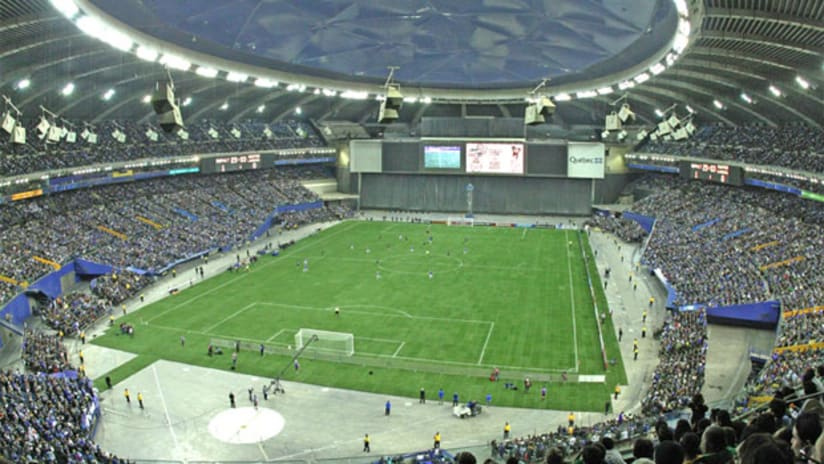Photo: Montreal's Olympic Stadium filled to capacity on February 25, 2009 (via le12ejoueur.ca).
For an example of the tremendous legacy that can come from hosting a CONCACAF Champions League quarterfinal game you need only look to Montreal.
The game that pitted the Montreal Impact, then of the United Soccer Leagues, against Mexican club Santos Laguna in Februrary 2009 helped lift the Impact into Major League Soccer and galvanized soccer fans in the province.
It was a lower case miracle, a 2-0 upset played before 55,571 spectators at the Olympic Stadium and it still stands as a blueprint for Toronto FC who have sold out the 45,000-seat Rogers Centre for Wednesday’s Champions League contest against the L.A. Galaxy.
“It’s funny that you would call,” said Richard Legendre, the Impact Executive Vice President. “I was just looking at a clip of the game a few days ago. It was unbelievable.”
“From our point of view,” said Legendre, “it was the perfect storm.”
RELATED: Reds prepare for LA Galaxy
RELATED: BMO Field delivers returns to the city
When the Impact advanced into the quarterfinal they were given no chance of beating Santos, a team plucked out of the ultra-competitive Mexican league. The bigger problem was the field. The Impact didn’t have one.
The club’s home pitch, Saputo Stadium was a non-starter in February. A host of bureaucratic and legal hurdles stood between the Impact and a date at the Big O.
Nine years before the building’s roof gave way and dumped snow on workers preparing the facility for an auto show. The body overseeing the stadium operation decided the stadium should be closed during the winter which is very much in force in Montreal in February.
Thus began a fevered saga of arm-twisting designed to prompt the government to make the stadium available.
“We had no Plan B,” said Legendre. “The closest place to play would have been the Rogers Centre. I say this with no disrespect but could you imagine a game between the Montreal Impact and Santos in Toronto?”
An eleventh-hour compromise was reached. It was agreed that the event could be shuttled if there was heavy snow on the roof. Weather records showed little chance of snow on that date and the Impact were counting on heat from inside the building transferring through the roof and melting any accumulation.
The controversy was a bonanza. The Impact were front-page news and their plucky battle against the bureaucratic red tape that governed the notoriously faulty stadium captured the imagination of Montrealers.
Suddenly a soccer game between a Mexican team and a local second division outfit had become an event. “We had an unbelievable amount of publicity that didn’t cost us a dime,” said Legendre.
The Impact sold out the stadium and then somehow beat Santos 2-0 before 55,571 wildly enthusiastic patrons. Eduardo Sebrango, still playing for the Impact at 38, is regularly approached by strangers who remember the two goals he struck that night.
“I knew they had sold a lot of tickets but I didn’t know what to expect when I stepped on the field,” said Sebrango. “What I remember most is how excited the crowd was. It was an amazing night. They cheered all the way through the game and they were cheering 15 minutes after it ended.”
It is an open question whether the team would be in the MLS without the Santos game but there is no debate that the game put the Impact on the map. It’s hard to ignore 55,000 people jamming a stadium in February.
“From a competitive and a business point of view, they might not have had any business being in that game but all of North America took notice and good for them,” said Paul Beirne, TFC’s director of business operations.
“They had a new legitimacy in the eyes of a whole lot of people who didn’t suspect they could bring that many people to a soccer game.”
As they enter their sixth season, TFC officials see the two leg series against the Galaxy as a chance to showcase the team’s dramatic improvement since the hiring of head coach Aron Winter.
“I think we have a great reach in the hearts and minds of our current fans, in the 20,000-50,000 range but there is a whole group of people who are aware of us who are interested and who love soccer. They’re the ones who will get us to 45,000 at Rogers Centre and help us grow in the Toronto sports landscape.”
There is a cautionary note here as well. A week later the Impact were beaten 5-2 in Mexico and Santos won the series five goals to four.
Remembering Montreal's CCL Run

